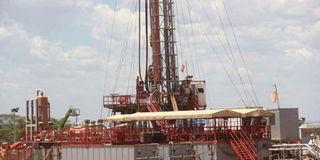Breaking News: At least 10 feared to have drowned in Makueni river
Curse of the black gold: Discovery of oil deposits in East Africa raises heat

Drilling machines at Cheptuket in Elgeyo-Marakwet County on March 17, 2016, where oil was discovered by Tullow Oil Company. PHOTO | JARED NYATAYA | NATION MEDIA GROUP
What you need to know:
Kenya is sure of 600 million barrels in Lokichar basin in Turkana County.
Uganda posts a higher figure of 6.5 billion barrels of oil in Hoima, Lake Albert basin.
The reality of discovering of oil has now hit Kenya and Uganda.
Debate over the route the pipeline that will take crude oil from Hoima and Lokichar to either Lamu Port or Tanga Port for export has been heating up.
When Juan Pablo Perez Alfonzo, a Venezuelan who founded the Organisation of Petroleum Exporting Countries (Opec), warned of the devil during the oil boom in 1970s, he was largely ignored.
He had foreseen the effects of oil when he said: “Ten years from now, 20 years from now, oil will bring us ruin. We are drowning in the Devil’s excrement.”
And events of last week could easily point to the ‘devil’ inherent in the discovery of oil in the world.
Kenya is sure of 600 million barrels in Lokichar basin in Turkana County, while Uganda posts a higher figure of 6.5 billion barrels in Hoima, Lake Albert basin.
But as Nicholas Shaxson explained in the book, “Poisoned Wells: The Dirty Politics of African Oil", discovery of the much sought after resource may not be a blessing as many expected.“Producing oil seems to be a bit like taking cocaine: if you are already healthy it might invigorate you, but if you are weak or sick, as many African countries are, it can do you serious harm,” Shaxson observes.
The reality of discovering of oil has now hit Kenya and Uganda.
OIL PIPELINE DEBATE
The two, emerging producers, are both staring at the onerous task of starting to produce oil in 2018.
Debate over the route the pipeline that will take crude oil from Hoima and Lokichar to either Lamu Port or Tanga Port for export has been heating up.
It is at such a stage, oil experts say, emerging producers quickly assemble specialists to negotiate with oil companies.
As it is, politicians and civil servants who sit in these teams are at a disadvantage because oil companies have highly trained executives who understand the inherent risks and potential profits from any negotiation.
A shortage of expertise in oil industry is what is playing out between Kenya, Uganda, Tanzania and the oil companies involved in deciding the route the pipeline will take.
The oil companies in question are Total S A, Chinese National Offshore Oil Corporation (CNOOC) and Tullow Oil plc.
The possible routes the pipeline can take are the Kenya North Route from Hoima to Lokichar to Lamu positing a distance of 1,476 kilometres while the second one is the Kenya South Route, which begins from Hoima to Nakuru to Mombasa with a spur line from Lokichar to the Nakuru tie-in point whose length is 1,544 kilometres.
The third is the Joint Tanga Route from Lokichar to Hoima to Tanga which is 2,028 kilometres and the fourth proposal is the standalone Tanga Route beginning from Hoima to Tanga for Uganda’s crude oil, a distance of 1,443 kilometres.
The last option is the standalone Kenya Route, posting 891 kilometres transporting Kenya’s crude only.
TOTAL S A STUDY
Three feasibility studies were carried out by the oil companies. The first one involving the trio while in the second, CNOOC teamed up with Tullow.
Total S A, then carried out its own study, which apparently is at the centre of the tussle between Kenya and Tanzania over transmission of Uganda’s oil.
A government report states: “In most aspects, there is a high degree of similarity between the studies, with the exception of the Total study. The Total study has not been undertaken to comparable level of maturity.”
The Total S A study shows that long and protracted land compensation deals could delay Hoima-Lokichar-Lamu pipeline construction, pushing up its cost.
The Northern Corridor Pipeline route has poor roads, lack airports as it traverses a vast hunting area which has low protection status.
It also states that the Lamu Port is behind schedule and it is also prone to seasonal monsoon winds which make it impossible for ships to dock.
In contrast, the Tanga Port is built and with a few refurbishments, it will be up and running. It is not affected by the monsoon winds.
Total also expressed fears over election related violence in Kenya and frequent terror attacks, stating its decision is irreversible.
President Yoweri Museveni delivered the same concerns to the government last week during the bilateral talks in Nairobi.
In February 2014, Uganda signed a deal with Total SA, Tullow and CNOOC for a refinery and an oil pipeline.
The MoU required the three companies to establish a refinery with Uganda given the discretion to choose the possible route of the pipeline through neighbouring countries, which would be least costly to the oil firms.
East African Community member States were subsequently invited to buy stakes in the proposed refinery, seen then as the solution to the region having to import expensive oil products.
Kenya and Uganda had also, in 2013, agreed to have a pipeline from Uganda to Lamu with an extension to Juba, South Sudan.
However, Total had been lobbying for a change of route. In July last year, the company’s vice-president for Eastern Africa, Mr Jabier Rielo, met President Museveni over the matter.
More than a week after President Kenyatta had toured Kampala in August, the Total chief travelled to Tanzania to meet authorities over the same matter.
During the East African Community Summit in Arusha early this month, Mr Museveni, and his Tanzanian counterpart, Mr John Magufuli, announced they had agreed to construct a pipeline through the southern route.





